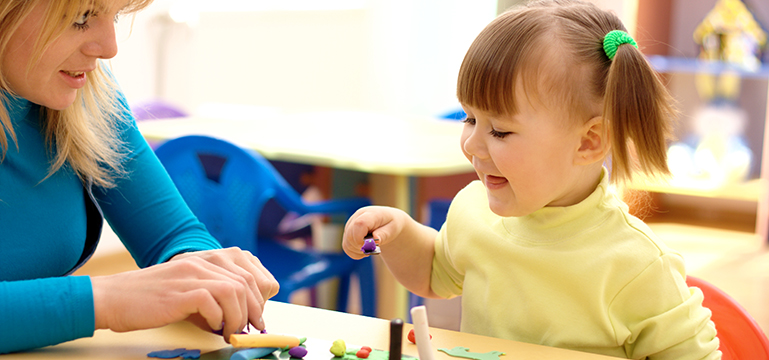Encouraging creative and physical skills in children

Quick links:
- Information about the setting
- Context and background to sector-leading practice
- Description of nature of strategy or activity identified as sector-leading practice
- Provision for physical development
- What impact has this work had on provision and learners’ standards?
- How have you shared your good practice?
Information about the setting
Aberporth Bilingual Early Years Playgroup is a voluntary run Playgroup for children between two to four years, located within the coastal village of Aberporth, Ceredigion and is within a Flying Start area. There are four full-time and two part-time members of staff. Two members of staff share the leadership role, one who has been in role since September 1985 and the other since September 2017. The setting is registered for 21 children and, at the time of the inspection, there were nine children in receipt of funded early education. Sessions are held every morning, during school term for five days each week.
Context and background to sector-leading practice
Practitioners at Early Years Playgroup Aberporth plan creatively to provide fun, stimulating activities that derive from and build upon children’s interests and questions. Practitioners continually reflect and evaluate standards and provision robustly to identify strengths and make changes to ensure that they meet the developing needs of all children. This is especially evident in their provision to develop children’s creative and physical skills.
Practitioners observed that children enjoyed creative development focus activities but the continuous provision arrangement was not providing them with sufficient opportunities to undertake activities independently and develop a wider range of skills.
The setting has no free-flow outdoor space, and therefore practitioners plan physical development provision very carefully and intentionally to ensure the development of all children’s wide ranging skills.
Description of nature of strategy or activity identified as sector-leading practice
During the sessions, children confidently move freely between enhanced continuous provision areas and focus tasks supported and challenged by practitioners through observations, skilful questioning and interactions. Practitioners reviewed their continuous provision areas and identified a need to reintroduce a performing area to develop children’s language and confidence when talking to others, singing and performing using music instruments. The most significant development was to improve the quality of the creative continuous provision area to offer children a wider variety of independent activities and greater opportunities to make choices and decisions. They prioritised funding and rearranged furniture to allow more floor space and standing table-top activities. They sorted, audited, purchased and rearranged resources by colour and type, such as joining materials – glue, tape, and making sure that there was a sufficient, accessible range. Initially, they included materials that were familiar to the children and observed children using the area to decide what resources they would remove or add to enhance learning and further skills development. Practitioners also observe who is accessing the area and make adaptations to encourage other children to use the area. Skills development is very evident within these observations and practitioners use these to plan further enhancements for example adding a greater variety of card thickness or as follow-up focus tasks, for example scissors skills activity.
Provision for physical development
The creative area also provides practitioners with a greater insight into the development and progress of children’s fine motor skills. Large motor skill development is planned intentionally through daily movement activity and by establishing a continuous provision Jabadao movement area. Despite the challenges of the building in terms of no access to free-flow outdoor area, practitioners make regular use of a variety of outdoor spaces nearby, such as the local school all weather play area, beach and village park. Before visiting, practitioners plan high quality purposeful activities through a variety of fun exciting games. These target the development of specific physical skills in addition to skills across other areas of learning, for example spatial awareness, different travelling movements, adjusting speed and direction, co-ordination, listening, counting, and expressing and managing emotions.
What impact has this work had on provision and learners’ standards?
Children’s ability to choose creative materials and make decisions has greatly improved. Their enjoyment and high level of independence are very evident, as well as their developing fine motor physical skills. They are able to persevere, show resilience, concentrate for longer periods and produce a wider range of creative work independently. They are more confident at experimenting with their own ideas and solving problems that arise. They confidently support others following what they have discovered and learnt themselves, such as using more glue when attaching materials. More children are using the area and are developing a wider variety of skills and producing creative samples of work.
Children’s spatial awareness, body control and co-ordination are developing progressively well, including children with additional learning needs. This is evident when they are using larger outdoor spaces as well as their indoor open space and Jabadao movement area.
These activities successfully target the development of specific physical skills in addition to skills across other areas of learning. Practitioners attend specific specialist training to update their knowledge and skills and ensure that provision supports and meets all children’s needs, especially children with additional learning needs. During the past year, practitioners have made better use of their knowledge of children’s skills development and their observations in planning enhanced opportunities across the continuous provision, including provision for skills development.
How have you shared your good practice?
Practice is shared with other staff and settings through network meetings and newsletters, for example, Flying Start, Healthy and Sustainable Preschool.
The LA and Flying Start Advisory Teachers share photographs and video clips during support visits to other settings and during training.